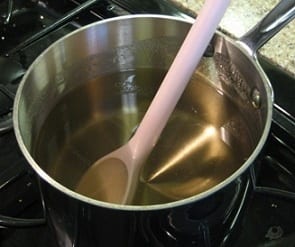For 1 kg of sugar, you need to take 1,5 liters of water. Pour about a third of the total amount of sugar into the saucepan. Put a saucepan with sugar on low heat and do not stir until sugar begins to caramelize. After all the sugar turns light brown, you will need to fill it with water, add the remaining sugar and add a few grams of vanilla. Cook the syrup until all the sugar is dissolved.
How to make caramel syrup
Products
To make 1 liter of caramel syrup, you need 1 kilogram of sugar, 1,5 liters of water and 3 grams of vanilla.
How to make caramel syrup
1. Put a third of the sugar in a saucepan, bring until light brown, stirring occasionally.
2. Pour the sugar over with water, add the rest of the sugar and vanilla.
3. Boil the caramel syrup to the required thickness for 10-15 minutes.
4. Then the caramel syrup must be filtered.
How to make jam syrup
Products
for 1 liter of syrup
Sugar – 1 kilogram
Water – 1 liter
Vanilla – 3 grams
How to make caramel syrup
1. Pour sugar with water and put on fire.
2. Bring the mixture to a boil and, without reducing the heat, cook for 2-3 minutes.
3. To evenly dissolve the sugar, the syrup must be constantly stirred and the foam removed.
4. Some of the sugar can be replaced with honey by adding it to a slightly cooled liquid and no longer boiling.
5. Cloudy syrup must be filtered through cheesecloth.
Delicious facts
– Syrup is a concentrated solution obtained by dissolving sugar in water or fruit juice. Most often, syrups are cooked in which the sugar content ranges from 30 to 80%. If the sugar concentration is below 60%, the syrup may ferment. Citric acid added at the end of the preparation will help to avoid souring the syrup.
– Syrups are used in the manufacture of canned fruits and berries, in the manufacture of compotes, in the preparation of jam, in the preparation of confectionery. Fruit syrups are added to cocktails and sodas.
– If necessary, invert syrup is brewed, which does not give sugar to sweet products. A thick, honey-like syrup is used in the manufacture of products that must remain marketable for a long time. Invert syrup is made by adding baking soda and citric acid to regular syrup. Replaces molasses in recipes where needed.
Syrup Sample Grades
The degree of density of the syrup can be determined using a special thermometer, or focusing on samples, each of which has its own characteristic external signs and purpose.
1. Liquid syrup. Contains some sugar, not thick or sticky. Used for preparing compotes.
2. Thin thread. Will stick to your hands. By squeezing and unclenching a drop of such syrup with your fingers, you can get a thin, easily torn thread. Used to make jam from dense fruits and berries.
3. Medium thread. A sticky syrup, a drop of which, when unclenched, produces a thin but strong thread. Suitable for preserving berries and fruits.
4. Thick thread. The syrup is much thicker, holds the fingers tightly, when unclenched, a strong thick thread is formed, which quickly hardens. Designed for canning berries and fruits, including soft varieties.
5. Weak sweetness. By dropping such syrups into cold water, you can see how it turns into a thick, loose mass. This test shows that the sugar is ready to thicken before the next stage.
6. Fudge. A small amount of syrup immersed in cold water forms a plastic ball that resembles butter. This syrup is used in the preparation of sweets.
7. Weak or semi-solid ball. A drop of syrup dipped in cold water resembles breadcrumb in consistency, from which soft balls can be sculpted. The syrup is used in the manufacture of candied fruit and fondant jams.
8. Solid or sturdy bead. A drop of syrup in cold water solidifies into a hard, dense ball. It is used in the manufacture of tackle.
9. Crackle. The syrup hardens into a thin film.
10. Caramel. A drop of syrup immersed in cold water hardens and breaks into small crystals.
11. Bypass. The syrup, in addition to the caramel strength, acquires a yellowish brown color.
12. Burnt. The sugar in the syrup turns brown and a characteristic burnt smell appears.
For canning and making jam, syrups 1 to 8 are intended.










